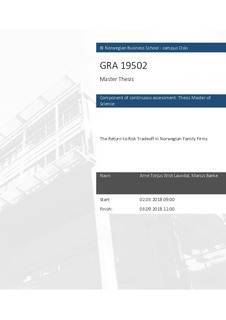The Return to Risk Tradeoff in Norwegian Family Firms
Master thesis
Permanent lenke
http://hdl.handle.net/11250/2579563Utgivelsesdato
2018Metadata
Vis full innførselSamlinger
- Master of Science [1621]
Sammendrag
In this master thesis we investigate whether a tradeoff between return and risk exists
for Norwegian non-listed family firms. Financial theory suggests that higher
performance in terms of return on an asset comes as a compensation for a higher
level of risk on that asset. Since the family relation between the controlling owners
of the firm, and or between the owners and the CEO, may induce other incentives
and motivations regarding return and risk preferences, this relationship seems to
break when it comes to non-listed family firms in Norway.
Previous literature is rather narrow by only separating between family and nonfamily
firms. In order to provide more transparency to the topic and new
contribution to literature, we define four different types of family firms. The
entrepreneurial family firms are where a single owner is also CEO, and the firm age
is not above ten years. The single owner family firms are where the owner is also
CEO and the firm age is above ten years. Further, we define the classical family
firms where there is more than one owner from a family where that family has
ultimate ownership above 50%. For the classical family firms, we divide between
those who have CEO from the family with the largest ultimate ownership and those
who do not.
According to theory and previous literature, the different firm types are supposed
to behave differently as a result of different governance structures and preferences
regarding time horizon for goal setting, profit maximization versus non-financial
benefits and possible agency costs. The findings of this thesis suggest that indeed,
the different firm types do behave differently, which may seem to have an effect on
the return to risk tradeoff. By breaking down the family firm structure in different
definitions, we learn that the picture is more nuanced and complex than initially
anticipated.
To investigate our hypothesis, the methodology for the core segment of analysis
includes pooled least squares models and fixed effects models. For the purpose of
robustness tests, propensity score matching models, Heckman self-selection models
and switching regressions models are used.
Consenting literature suggests that young entrepreneurial firms take on extensive
risk without obtaining the performance to justify it. To investigate whether this
relationship holds for the Norwegian firms, an additional cohort study is also
conducted. We use the same methodology regarding models, however the sample is quite different. In this study we compare firms which are born in the same year
over five years. The cohort sample also allows us to make descriptive inferences
regarding firm survival.
The thesis provides evidence which suggests that all family firms with family CEO,
compared to non-family firms, seem to enjoy higher performance, measured by
return on assets, while bearing less risk, measured by volatility in revenue. Finally,
the entrepreneurial family firms and the classical family firms with family CEO are
associated with the highest return to risk ratio. Most intriguing is it that the results
from the core analysis and the cohort study find contradicting evidence to the
literature which suggests that entrepreneurial firms are burning money. Striking
results suggest that the return to risk tradeoff from financial theory may not hold
and thus provide evidence to support that family related characteristics indeed have
an effect on performance, risk and the return to risk tradeoff.
Beskrivelse
Masteroppgave(MSc) in Master of Science in Business, Finance - Handelshøyskolen BI, 2018
